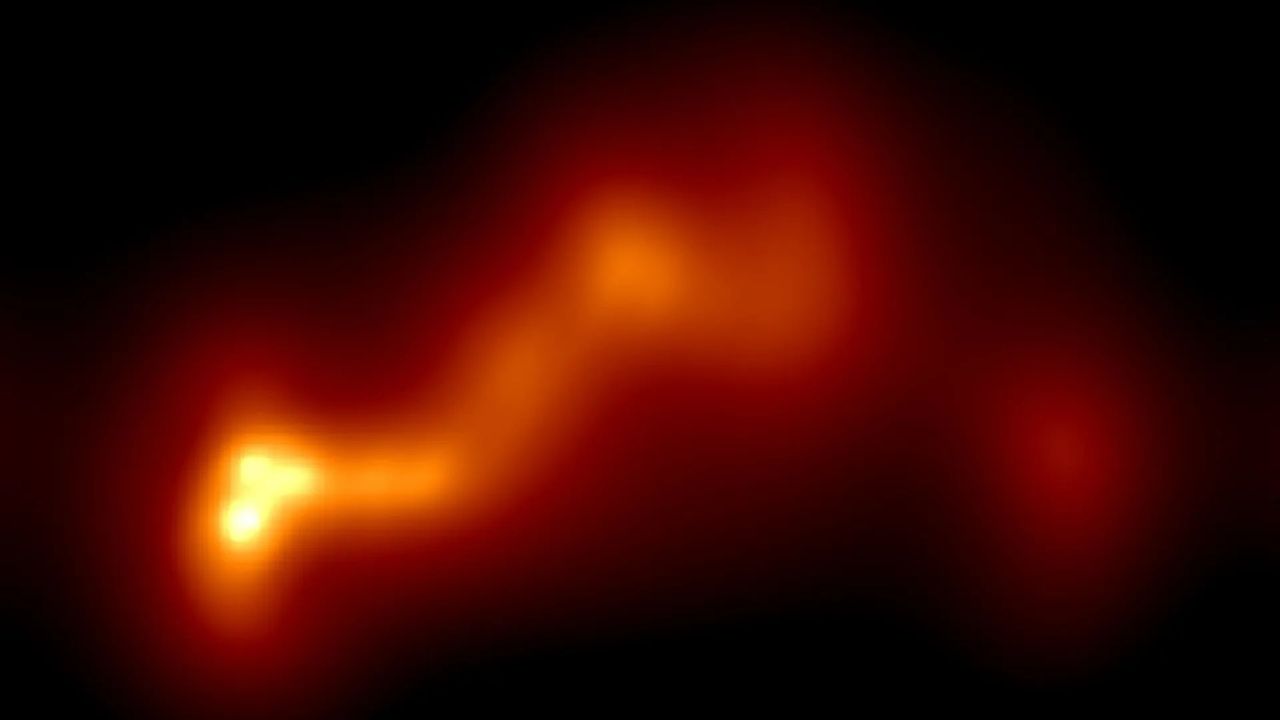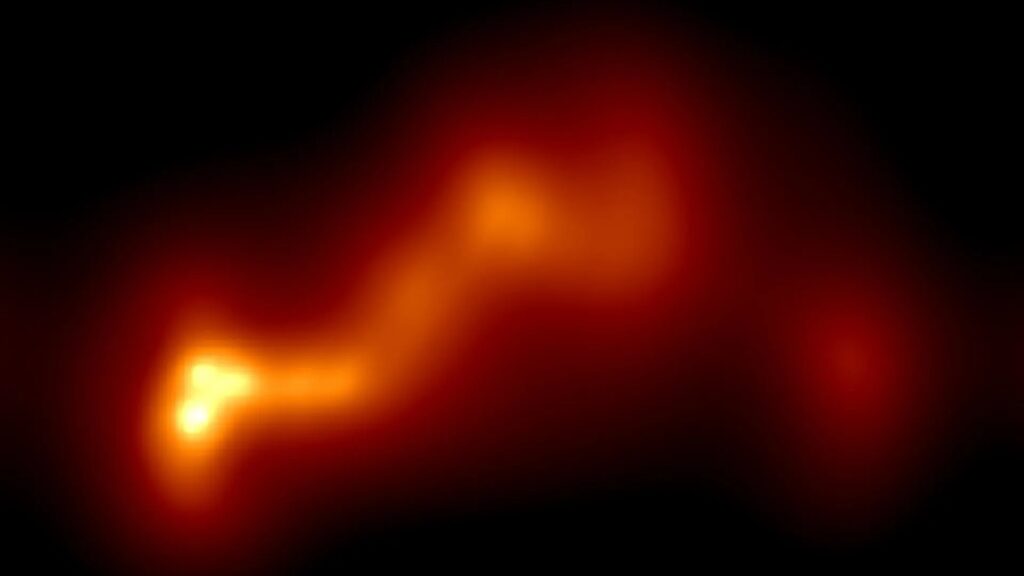
A beam of particles speeding away from the vicinity of a monstrous black hole has been found to be severely kinked, providing compelling evidence that the black hole is actually part of the most extreme binary system known.
The black hole and its crooked jet are found in a blazar known as OJ 287, located about four billion light-years away. A blazar is a quasar seen head-on, and a quasar is the active core of a galaxy where the resident supermassive black hole is pulling in huge amounts of matter. That matter spirals around the black hole, forming what’s called an accretion disk, and there’s so much matter that the accretion disk becomes a bottleneck.
Rather than flowing into the black hole’s maw, the infalling matter piles up in the disk, the density and temperature dramatically increasing such that it shines so brightly that it can be seen across the universe. Magnetic fields wrapped up in the accretion disk are able to funnel some of the charged particles in the matter away from the black hole, collimating them and accelerating them in two opposing jets that blast away from the black hole for thousands of light-years at close to the speed of light. Because we see blazars almost head-on, they appear even brighter than regular quasars.
However, OJ 287 is not your ordinary blazar. Astronomers have been tracking its cycles of brightness variations for about 150 years — from even before they knew what kind of object it is. There’s a long cycle of approximately 60 years, and a shorter cycle with a period of variation of just 12 years.
This short cycle has been attributed to a companion black hole with about 150 million times the mass of the sun orbiting the main black hole, which has been claimed to have a mass equivalent to a whopping 18.35 billion suns. Both black holes are gargantuan compared to Sagittarius A*, which is the 4.1-million-solar-mass black hole at the centre of our Milky Way galaxy.
The less massive black hole moves on an elongated, elliptical orbit. Every 12 years, it plows through the accretion disk of the more massive black hole. As it does so, it steals some of the matter from the disk and forms its own temporary accretion disk, with a temporary jet. For a short time, the OJ 287 system turns into a double quasar.
Related: Monster black hole jet from the early universe is basking in the ‘afterglow’ of the Big Bang
At least, that’s the hypothesis. Previous observations seem to support the idea. For example, in 2021, as predicted, the OJ 287 system dramatically increased in brightness in just 12 hours as the second black hole encountered the primary’s disk and lit up as a quasar, releasing more energy in that short time than 100 average galaxies put together.
Now, the most detailed image ever of the permanent jet blasting away from the more massive black hole, taken by a network of radio telescopes on Earth and in space, strongly supports the binary black hole model.
“We have never before observed a structure in the OJ 287 galaxy at the level of details seen in the new image,” said radio astronomer Efthalia Traianou of Heidelberg University in Germany, who led the observations, in a statement.
The radio observations were performed by combining the 10 radio telescopes of the Very Long Baseline Array (VLBA) across the United States with the RadioAstron 10-meter antenna on the Russian Spektr-R satellite. The observations were made between 2014 and 2017, and the mission itself ended in 2019, before Russia invaded Ukraine and was subjected to sanctions.
Combined, the ground-to-space radio telescope network formed an interferometer with a baseline (i.e., its virtual aperture) that was five times the diameter of Earth, and this enabled sensational resolving power. The resulting image zooms in on the center of OJ 287, showing a region just a third of a light-year across. The radio-wavelength image shows that the black hole’s jet is not straight, but is crooked with three distinct bends. The observations between 2014 and 2017 further revealed that the angle of the jet varied by about 30 degrees, and this image proves that the reorientation of the jet takes place very close to its point of origin.
This severe reorientation could be the result of the gravity of the orbiting second black hole pulling on the jet, causing it to bend and precess about its axis.
The radio wavelength images also captured a shock wave forming as the result of a new jet component. As this shock wave propagated up the jet, it released a torrent of high-energy gamma rays that were detected by the likes of NASA’s Fermi Space Telescope and Swift mission.
Some parts of the jet seem to radiate at an incredible 10 trillion degrees Celsius. Such a temperature seems unimaginable in human experience, and indeed this temperature is too hot to be true. It is an illusion in which we are seeing the effect of a phenomenon called relativistic beaming, where the Doppler effect boosts the luminosity of things that are moving toward us at close to the speed of light.
As a potential binary black hole, OJ 287 has other important uses too.
“Its special properties make the galaxy an ideal candidate for further research into merging black holes and the associated gravitational waves,” said Traianou.
Although the two proposed black holes in the OJ 287 system will collide and merge eventually, this titanic event won’t take place any time soon. However, their inevitable in-spiral into each other is releasing constantly weak gravitational waves. Our current gravitational-wave detectors cannot detect these gravitational waves because they are too weak and their wavelength is too great. Potentially, pulsar timing arrays, in which the timing of the regular-as-clockwork pulses from spinning pulsars become disrupted as gravitational waves pass between us and the pulsars, could detect the gravitational waves from OJ 287.
Further into the future, the European Space Agency’s Laser Interferometer Space Antenna (LISA) mission, which is hoped to launch in the mid-2030s, could detect the eventual mergers of such binary supermassive black holes, which produce gravitational waves with wavelengths too long for Earth-bound detectors to spot.
The findings were published July 30 in the journal Astronomy & Astrophysics.
